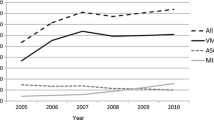Abstract
Introduction and hypothesis
The effect of a Pelvicol® graft compared with a conventional anterior vaginal repair was evaluated in this randomised controlled study.
Methods
Only patients with a stage II or higher (Ba ≥ −1) defect were included.
Results
Thirty-one patients were allocated to a conventional anterior repair; 30 to Pelvicol® graft. At 12 months follow-up, four patients among controls (15%) and two in the graft group (7%) had objective recurrence. Among controls, the difference at 3 months follow-up in Ba was 6.0 cm when compared with the position of Ba prior to surgery. In the graft group, the difference was 7.0 cm (P < 0.05). This difference was still present at 12 months follow-up (6.0 vs. 7.0 cm; P < 0.05).
Conclusions
The implantation of a Pelvicol® graft does not improve the POP-Q stage.


Similar content being viewed by others
References
Olsen AL, Smith VJ, Bergstrom JO, Colling JC, Clark AL (2001) Epidemiology of surgically managed pelvic organ prolapse and urinary incontinence. Obstet Gynecol 89:501–506
Nguyen JK (2001) Current concepts in the diagnosis and surgical repair of anterior vaginal prolapse due to paravaginal defects. Obstet Gynecol Surv 56:239–246
Richardson AC, Edmonds PB, Williams NL (1981) Treatment of stress urinary incontinence due to paravaginal fascial defect. Obstet Gynecol 57:357–362
Delancey JO (2002) Fascial and muscular abnormalities in women with urethral hypermobility and anterior vaginal wall prolapse. Am J Obstet Gynecol 187:93–99
Tunn R, Rieprich M, Kaufmann O, Gauruder-Burmester A, Beyersdorff D (2005) Morphology of the suburethral pubocervical fascia in women with stress urinary incontinence: a comparison of histologic and MRI findings. Int Urogynecol J Pelvic Floor Dysfunct 16:480–486
Morse AN, O’Dell KK, Hovard AE, Baker SP, Aronson MP, Young SB (2007) Midline anterior repair alone vs anterior repair plus vaginal paravaginal repair: a comparison of anatomic and quality of life outcome. Int Urogynecol J 18:245–249
Weber AM, Walters MD, Piedmonte MR, Ballard LA (2001) Anterior colporrhaphy: a randomized trial of three surgical techniques. Am J Obstet Gynecol 185:1299–1304
Sand PK, Koduri S, Lobel RW, Winkler HA, Tomezsko J, Culligan PJ, Goldberg R (2001) Prospective randomized trial of polyglactin 910 mesh to prevent recurrence of cystoceles and rectoceles. Am J Obstet Gynecol 184:1357–1362
Raz S, Little NA, Juma S, Sussman EM (1991) Repair of severe anterior vaginal wall prolapse (grade IV cystourethrocele). J Urol 146:988–992
Handel LN, Frenkl TL, Kim YH (2007) Results of cystocele repair: a comparison of traditional anterior colporrhaphy, polypropylene mesh and porcine dermis. J Urol 178:153–156
Nguyen JN, Burchette RJ (2008) Outcome after anterior vaginal prolapse repair. Obstet Gynecol 111:981–988
Altman D, Väyrynen T, Engh ME, Axelsen S, Falconer C (2008) Short-term outcome after transvaginal mesh repair of pelvic organ prolapse. Int Urogynecol J 19:787–793
Meschia M, Pifarotti P, Bernasconi F, Magatti F, Riva D, Kocjancic E (2007) Porcine skin collagen implants to prevent anterior vaginal wall prolapse recurrence: a multicenter, randomized study. J Urol 177:192–195
David-Montefiore E, Barranger E, Dubernard G, Detchev R, Nizard V, Daraï E (2005) Treatment of genital prolapse by hammock using porcine skin collagen implant (Pelvicol). Urology 66(6):1314–1318
de Tayrac R, Devoldere G, Renaudie J, Villard P, Guilbaud O, Eglin G, French Ugytex Study Group (2007) Prolapse repair by vaginal route using a new protected low-weight polypropylene mesh: 1-year functional and anatomical outcome in a prospective multicentre study. Int Urogynecol J Pelvic Floor Dysfunct 18:251–256
Maher C, Baessler K, Glazener CM, Adams EJ, Hagen S (2008) Surgical management of pelvic organ prolapse in women: a short version Cochrane review. Neurourol Urodyn 27:3–12
Rudnicki M (2007) Biomesh (Pelvicol) erosion following repair of anterior vaginal wall prolapse. Int Urogynecol J Pelvic Floor Dysfunct 18:693–695
Conflicts of interest
None.
Author information
Authors and Affiliations
Corresponding author
Rights and permissions
About this article
Cite this article
Hviid, U., Hviid, T.V.F. & Rudnicki, M. Porcine skin collagen implants for anterior vaginal wall prolapse: a randomised prospective controlled study. Int Urogynecol J 21, 529–534 (2010). https://doi.org/10.1007/s00192-009-1018-3
Received:
Accepted:
Published:
Issue Date:
DOI: https://doi.org/10.1007/s00192-009-1018-3




